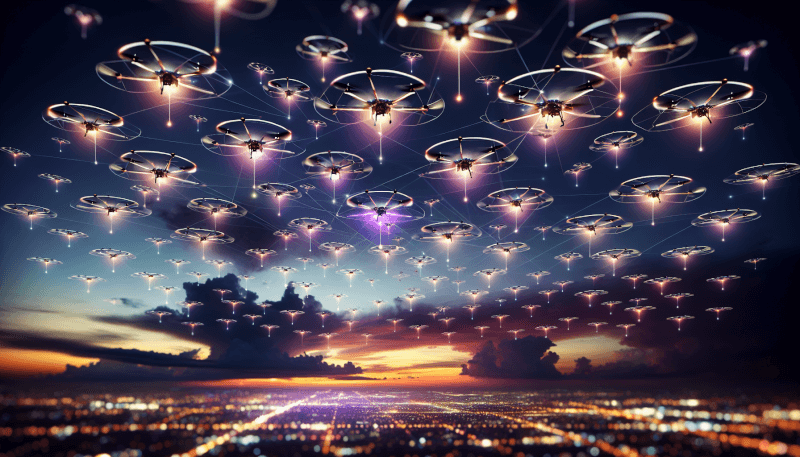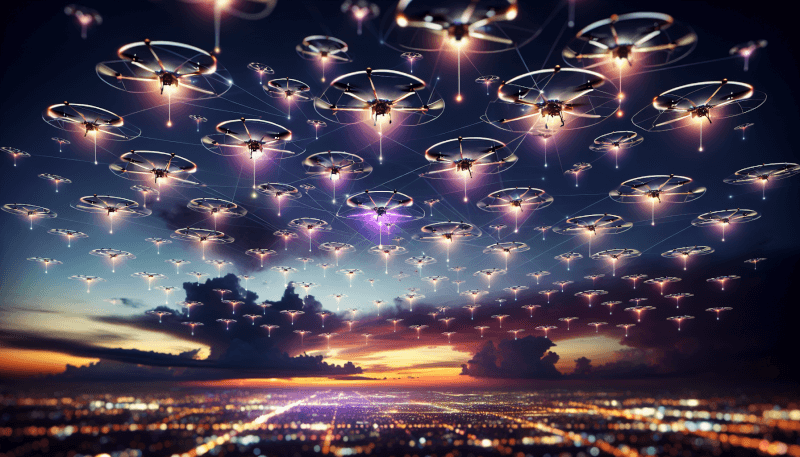Imagine you’re standing in an open field, mesmerized by a symphony of drones gracefully gliding through the sky, moving in perfect harmony. This captivating sight is made possible by drone swarming technology, a revolutionary innovation that enables multiple drones to work together seamlessly. By understanding how this advanced system operates, you’ll gain insight into its limitless potential, from enhancing military operations to transforming industries like agriculture and entertainment. Brace yourself for an enlightening journey into the world of drone swarming technology.
What is Drone Swarming Technology
Definition of drone swarming technology
Drone swarming technology refers to the coordination and operation of multiple drones working together in a synchronized manner. It involves the use of specialized algorithms and communication systems to enable drones to act as a collective unit, just like a swarm of bees or a flock of birds. This technology allows for increased efficiency, improved data collection, and a wide range of applications across various industries.
How drone swarms operate
Drone swarms operate by leveraging swarm intelligence algorithms and communication protocols to ensure collaborative behavior among the drones. Each drone in the swarm is equipped with sensors and a communication module that allows it to exchange information with other drones in real-time. This enables them to gather and share data, adapt to changing environments, and perform tasks collectively. By working together, drone swarms can achieve tasks that would be difficult or impossible for a single drone to accomplish.
Advantages of drone swarming technology
Drone swarming technology offers several advantages over individual drone operations. Firstly, it allows for increased efficiency and productivity. By having multiple drones working together, tasks can be completed more quickly and effectively. Secondly, drone swarms enable improved data collection and analysis. With multiple drones gathering data simultaneously, a more comprehensive and accurate picture of the environment or target can be obtained. Additionally, drone swarms enhance safety by providing redundancy. If one drone fails or loses communication, the rest of the swarm can compensate and continue the mission. Lastly, drone swarms have the potential to be cost-effective. By utilizing a swarm of smaller and cheaper drones, the overall cost of operations can be significantly reduced.
Types of Drone Swarms
Fixed Drone Swarm
A fixed drone swarm consists of a predetermined number of drones that operate in a fixed formation and follow pre-programmed flight paths. These swarms are often used for aerial displays, light shows, or artistic performances. Fixed drone swarms can create mesmerizing patterns and shapes in the sky, captivating audiences with their synchronized movements and stunning visual displays.
Shape-Shifting Drone Swarm
Shape-shifting drone swarms are designed to change their formation and arrangement during flight. These swarms are capable of dynamically altering their shape and adapting to different environments or mission requirements. Shape-shifting drone swarms are particularly useful in search and rescue operations, where they can modify their formation to cover large areas or navigate through complex terrains.
Self-Organizing Drone Swarm
Self-organizing drone swarms are capable of autonomously coordinating their actions without the need for a centralized control system. Each drone in the swarm operates based on local information and communicates with neighboring drones to achieve a common goal. This decentralized approach allows for greater flexibility, adaptability, and robustness in swarm operations. Self-organizing drone swarms have applications in various fields, including agriculture, where they can efficiently distribute resources or monitor crop conditions.
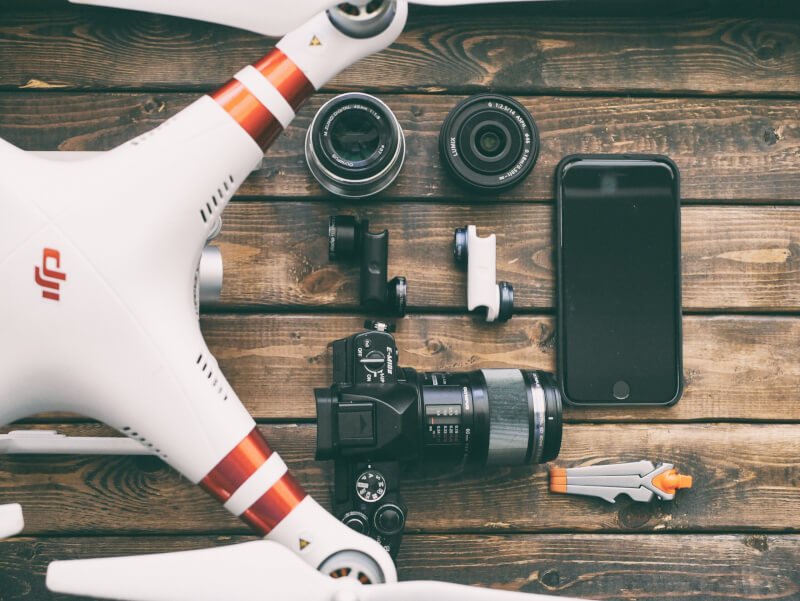
Applications of Drone Swarming Technology
Military and Defense
Drone swarming technology has significant applications in military and defense operations. Swarms of drones can be used for reconnaissance missions, intelligence gathering, or surveillance operations in hostile environments. They can also be deployed for offensive purposes, such as autonomous attacks or swarm-based defense strategies. The ability of drone swarms to overwhelm adversaries, operate in complex and unpredictable terrains, and adapt to changing situations makes them a valuable asset for armed forces around the world.
Search and Rescue Operations
Drone swarms can play a crucial role in search and rescue operations, particularly in situations where time is of the essence. They can cover large areas more quickly and effectively than individual drones, allowing for faster detection and response to emergencies. Drone swarms equipped with thermal imaging cameras or other specialized sensors can locate missing persons, assess disaster areas, and provide real-time updates to rescue teams. The ability of drone swarms to work collaboratively and cover expansive search areas significantly improves the chances of successful rescue missions.
Agriculture
In the agricultural industry, drone swarming technology has the potential to revolutionize farming practices and increase productivity. Swarms of drones can be used for crop monitoring, irrigation management, and precision spraying of fertilizers or pesticides. By distributing resources more efficiently and detecting plant health issues early, drone swarms can help optimize crop yields and reduce the environmental impact of farming. Additionally, the use of drone swarms can alleviate labor-intensive tasks, making agriculture more cost-effective and sustainable.
Construction and Infrastructure
Drone swarms have applications in the construction and infrastructure sectors. They can be utilized for site surveys, 3D mapping, and inspections of structures such as bridges, buildings, or pipelines. By collecting high-resolution aerial data, drone swarms enable faster and more accurate assessment of construction sites, identifying potential safety hazards or design flaws. The ability of drone swarms to access difficult-to-reach areas and provide real-time information to project managers and engineers can significantly improve the efficiency and safety of construction projects.
Key Components of Drone Swarming Technology
Communication and Connectivity
Effective communication and connectivity are essential for drone swarming technology. Each drone in the swarm must be able to exchange information with other drones in real-time. This requires reliable communication links and protocols that can handle the large amount of data generated by multiple drones simultaneously. Communication systems in drone swarms can be based on various technologies, including Wi-Fi, Bluetooth, or proprietary protocols.
Swarm Intelligence Algorithms
Swarm intelligence algorithms are the foundation of drone swarming technology. These algorithms enable drones to behave collectively, making decisions based on local and global information. Swarm intelligence algorithms take inspiration from natural swarm behaviors, such as ant colonies or bird flocks. They allow drones to adapt to changing circumstances, self-organize, and distribute tasks efficiently within the swarm.
Centralized or Decentralized Control
Drone swarms can be controlled in a centralized or decentralized manner. In a centralized control system, a designated drone or ground station coordinates the actions of all the drones in the swarm. This approach provides precise control but can be susceptible to single points of failure. In a decentralized control system, each drone operates autonomously, making decisions based on local information and communication with neighboring drones. Decentralized control allows for greater flexibility and robustness but requires effective communication and coordination among the drones.
Sensor Integration
Drones in a swarm need to gather and process data from their surroundings to achieve their objectives. Sensor integration plays a crucial role in drone swarming technology. Drones can be equipped with various sensors, such as cameras, LiDAR, thermal imaging, or environmental sensors, depending on the specific application. The data collected by these sensors is used to make informed decisions and facilitate collaboration within the swarm.
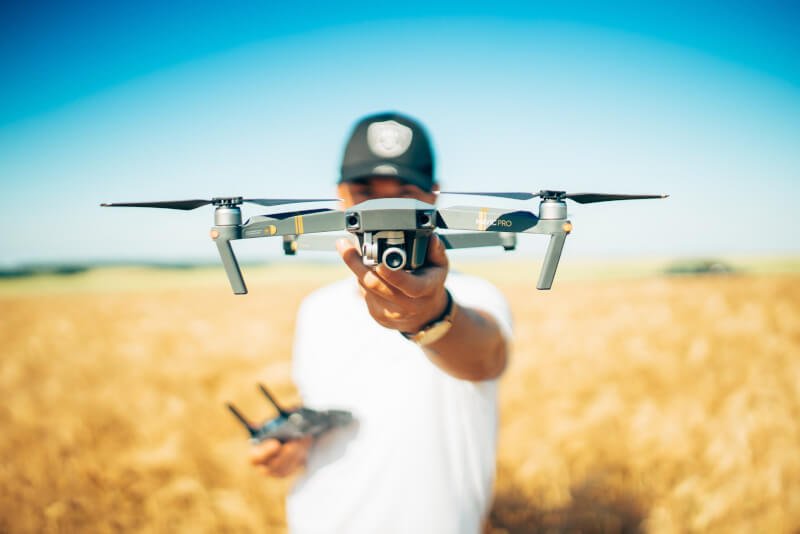
Challenges and Considerations
Safety and Regulations
As drone swarming technology continues to advance, safety and regulations become increasingly important. Ensuring the safe operation of drone swarms in crowded airspace or urban environments poses significant challenges. Collision avoidance systems, airspace management, and regulations governing the use of drone swarms are essential to mitigate risks and ensure public safety. It is imperative to establish clear guidelines and standards for the safe integration and operation of drone swarms.
Autonomy and Artificial Intelligence
The autonomy of drone swarms raises ethical and legal considerations. As drone swarming technology becomes more sophisticated, the level of autonomy and decision-making capabilities of the drones increases. This raises questions about accountability, liability, and potential unintended consequences. The development of robust artificial intelligence algorithms and ethical frameworks is necessary to address these challenges and ensure the responsible use of drone swarms.
Cybersecurity Risks
The interconnected nature of drone swarms makes them vulnerable to cybersecurity threats. Hackers could potentially gain control of the swarm or intercept communication channels, leading to unauthorized access or manipulation of data. Securing the communication links, employing encryption algorithms, and implementing intrusion detection systems are critical to safeguarding drone swarms against cyber attacks.
Interference and Jamming
Interference and jamming pose significant challenges to the operation of drone swarms. In congested electromagnetic environments, such as urban areas or near military installations, the communication signals of the drones can be disrupted or jammed. This can lead to communication breakdowns, loss of swarm cohesion, or even complete mission failure. Developing robust communication protocols and anti-jamming measures is essential to ensure the reliable operation of drone swarms.
Ethical and Legal Implications
The use of drone swarms raises ethical dilemmas and legal implications. Privacy concerns arise when drones are used for surveillance or data collection, raising questions about the collection, storage, and use of personal information. Moreover, the potential misuse of drone swarms for malicious purposes, such as weaponization or surveillance without consent, requires careful regulation and ethical guidelines. It is crucial to establish a balance between the benefits of drone swarming technology and protecting individual rights and societal values.
Future Developments and Trends
Increased Autonomy and Artificial Intelligence
The future of drone swarming technology lies in increased autonomy and artificial intelligence. Advances in machine learning, computer vision, and decision-making algorithms will enable drones to operate more independently and adapt to complex and dynamic environments. Autonomous swarm behavior, combined with intelligent decision-making capabilities, will unlock new possibilities and applications for drone swarming technology.
Enhanced Swarm Communication and Coordination
Improvements in swarm communication and coordination will further enhance the capabilities of drone swarms. Faster and more reliable communication protocols, such as 5G networks or satellite links, will enable swarms to operate over larger distances and in more challenging environments. Enhanced coordination algorithms will allow for more efficient swarm behavior, enabling drones to perform complex tasks together seamlessly.
Integration with Internet of Things (IoT)
The integration of drone swarms with the Internet of Things (IoT) will enable a new level of connectivity and collaboration. By interacting with other IoT devices and systems, drone swarms can leverage real-time data and external information to enhance their decision-making processes. This integration opens up possibilities for applications in smart cities, disaster response, or environmental monitoring.
Miniaturization and Swarm Scalability
Advancements in miniaturization technology will lead to smaller, lighter, and more agile drones. Miniaturized drones can swarm in larger numbers, providing increased coverage and capabilities. Swarm scalability will allow for the deployment of hundreds or even thousands of drones, enabling the execution of complex tasks or missions on a massive scale.

Examples of Drone Swarming Technology
Intel Shooting Star Drone Show
The Intel Shooting Star drone show is a stunning example of drone swarming technology used in entertainment. It features hundreds of drones flying in synchronized patterns to create breathtaking light shows in the night sky. These drone swarms are meticulously choreographed and programmed to perform complex aerial displays, captivating audiences around the world.
Military Drone Swarms
Military applications of drone swarming technology are rapidly advancing. Countries like the United States, China, and Russia are investing heavily in the development of military drone swarms for various purposes. These swarms can be used for reconnaissance, surveillance, and targeted strikes. They offer strategic advantages, such as overwhelming enemy defenses or providing enhanced situational awareness in battlefields.
Agricultural Crop Spraying Drones
Drone swarms are revolutionizing agriculture by enabling precision crop spraying. Instead of relying on human-operated machinery, drone swarms equipped with specialized spraying systems can efficiently distribute fertilizers, pesticides, or herbicides over crops. This targeted approach reduces chemical usage, minimizes environmental impact, and increases farm productivity.
Commercial Drone Delivery Swarms
Companies like Amazon and DHL are exploring the use of drone swarms for commercial package delivery. Instead of using one drone per delivery, swarm-based systems can enable multiple drones to work together to transport packages to their destinations. This approach provides faster and more efficient delivery services, particularly in areas with high volumes of orders or remote locations.
Benefits and Impact of Drone Swarming Technology
Efficiency and Cost Reduction
Drone swarming technology offers increased efficiency and cost reduction across various industries. By leveraging the collective power of multiple drones, tasks can be completed more quickly, saving time and resources. The use of smaller and cheaper drones in a swarm can significantly reduce operational costs, making drone swarming technology an attractive option for businesses and organizations.
Improved Data Collection and Analysis
Drone swarms enhance data collection and analysis capabilities. With multiple drones gathering data simultaneously, a more comprehensive and accurate picture of the environment or target can be obtained. This data can be analyzed in real-time or later, allowing for informed decision-making, predictive analysis, and actionable insights. Improved data collection and analysis lead to better-informed strategies, improved operational efficiency, and optimized resource allocation.
Enhanced Safety and Performance
Drone swarms provide enhanced safety and performance compared to individual drones. By leveraging redundancy in the swarm, a single drone failure or loss of communication does not result in mission failure. The remaining drones can compensate for the missing drone, continuing the task or mission effectively. This redundancy enhances the safety and reliability of operations, particularly in critical applications such as search and rescue or military operations.
Innovation and Economic Opportunities
Drone swarming technology opens up a new era of innovation and economic opportunities. It enables the development of novel applications and services that were once impossible or impractical. Industries can leverage drone swarms to improve existing processes, create new business models, and explore uncharted territories. The adoption and advancement of drone swarming technology stimulate economic growth, job creation, and technological advancements.
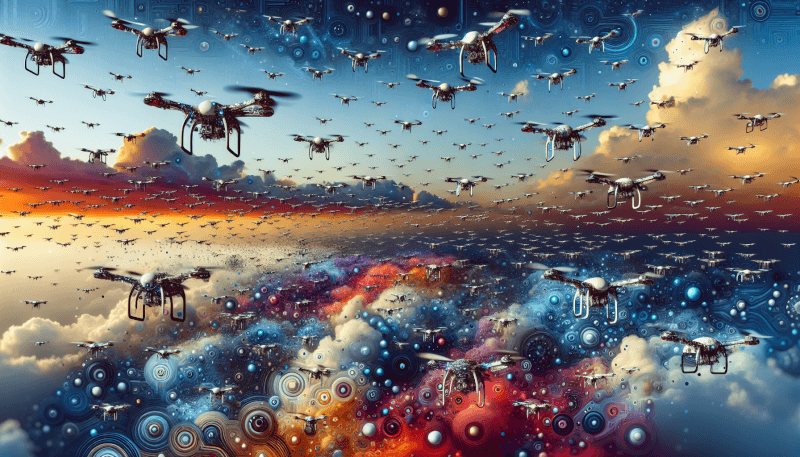
Ethical and Legal Considerations
Privacy Issues
The use of drone swarms raises concerns about privacy. Drones equipped with cameras or other surveillance capabilities can infringe upon individual privacy rights when deployed for unauthorized surveillance or data collection. Clear policies, regulations, and guidelines are needed to protect individual privacy and ensure responsible and transparent use of drone swarms.
Security and Misuse
The potential use of drone swarms for malicious purposes raises security concerns. Drones can carry payloads that pose threats to public safety or critical infrastructure. Protecting against the misuse of drone swarms requires the establishment of robust security measures, such as geofencing, anti-drone systems, or counter-drone technology. Collaboration among governments, law enforcement agencies, and industry stakeholders is essential to address security challenges effectively.
Regulation and Policy Framework
The rapid development and adoption of drone swarming technology present regulatory challenges. Authorities need to establish clear guidelines and regulations governing the operation of drone swarms. These regulations should address safety, privacy, security, and ethical considerations. Striking the right balance between promoting innovation and safeguarding public interests is crucial in fostering responsible and productive use of drone swarming technology.
Conclusion
Drone swarming technology is revolutionizing industries and opening up new possibilities. With increased efficiency, improved data collection, and a wide range of applications, drone swarms are becoming an integral part of various sectors. The advancements in autonomy, communication, and sensor integration will drive the future growth of drone swarming technology. However, careful attention must be paid to safety, privacy, security, and ethical considerations. By addressing these challenges and harnessing the potential of drone swarming technology responsibly, we can unlock its full benefits, drive innovation, and create a better future.
